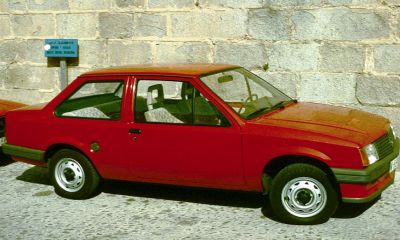 1983 Vauxhall Nova Dimensions, Size & Specs
1983 Vauxhall Nova Dimensions, Size & SpecsMeasurements of the 1983 Vauxhall Nova, engineered for optimal performance and comfort
| Dimensions | |
|---|---|
| Length: | 3955 mm155.7 in13.0 ft |
| Width: | 1541 mm60.7 in5.1 ft |
| Height: | 1358 mm53.5 in4.5 ft |
| Weight Specifications | |
| Curb Weight: | 739-930 kg1629-2050 lbs |
| Maximal permitted Weight: | 1215-1410 kg2679-3109 lbs |
| Tire Specifications | |
| Rims Sizes: | 14-inch rims:
|
| Tire Sizes: |
|
The Vauxhall Nova, produced between 1983 and 1993, is a compact sedan that made a distinctive mark in the small car segment of the 1980s and early 1990s. Its dimensions positioned it as a practical city car, offering a length of 3955 mm (155.7 inches), a width of 1541 mm (60.7 inches), and a height of 1358 mm (53.5 inches). This compact footprint allowed for easy maneuverability and convenient parking in urban environments while providing a comfortable cabin space for passengers.
Weighing between 739 kg and 930 kg (approximately 1,629 to 2,050 lbs) curb weight depending on the specific model and trim level, the Nova was lightweight yet solidly built, contributing to its fuel efficiency and nimble handling. The vehicle's maximum permissible weight ranged from 1215 kg to 1410 kg (2,679 to 3,109 lbs), accommodating passengers and cargo without compromising driving dynamics.
Equipped typically with 5J x 14 or 5J x 13 rims paired with tire sizes of 165/65 R14 or 165/70 R13, the Vauxhall Nova balanced ride comfort and road grip. Its modestly sized wheels complemented the car's compact design ethos, enhancing its agility on a variety of road surfaces.
The Nova’s sleek yet functional styling, combined with its practical dimensions, made it a popular choice for drivers prioritizing economy without sacrificing everyday usability. Its narrow body width of just over 1.5 meters made it particularly suited to narrow European streets, while its overall length under 4 meters kept it competitive in the subcompact category.
In summary, the Vauxhall Nova from 1983 to 1993 stands out as an efficient, space-conscious sedan that delivered practical driving in a lightweight package. Its dimension and weight figures remain relevant for enthusiasts and buyers looking to understand historic small sedan sizing and performance characteristics within the European car market of the era.
Discover the standout features that make the 1983 Vauxhall Nova a leader in its class
Have a question? Please check our knowledgebase first.
The Vauxhall Nova, produced between 1983 and 1993, has a length of 3955 mm (155.7 inches) and a width of 1541 mm (60.7 inches). These dimensions classify it as a compact sedan, suitable for urban driving and easy maneuverability. The compact width allows for easier parking and handling in tighter spaces compared to larger sedans of the era.
The height of the Vauxhall Nova stands at 1358 mm (53.5 inches), giving it a relatively low profile that can aid in aerodynamics and handling. Its curb weight varies from 739 kg to 930 kg (approximately 1,629 to 2,050 pounds), depending on the specific trim and engine configuration. This relatively light weight contributes to fuel efficiency and nimble performance.
The maximum weight (gross vehicle weight) of the Vauxhall Nova ranges from 1215 kg to 1410 kg (2678 to 3109 pounds). This includes the weight of the vehicle itself plus passengers, cargo, and fuel. This relatively moderate maximum weight indicates a practical carrying capacity for small families or daily commuting needs without compromising vehicle stability or safety.
The Vauxhall Nova typically uses rims sized 5J x 14 or 5J x 13 inches, paired with tire sizes 165/65 R14 or 165/70 R13. This combination was standard for compact cars of its time, providing a balance between ride comfort, grip, and fuel economy. The tire width of 165 mm and aspect ratios of 65 and 70 help maintain good road contact without sacrificing efficiency.
Yes, the Vauxhall Nova comfortably fits into a standard garage. Considering average garage dimensions of roughly 2.4 meters (7.9 feet) in width and 5.4 meters (17.7 feet) in length, the Nova’s length of 3.955 meters (12.98 feet) and width of 1.541 meters (5.06 feet) allow it to park easily with adequate clearance on all sides. The modest height of 1.358 meters (4.45 feet) also means you won’t face any vertical clearance issues.
The Vauxhall Nova replaced the Vauxhall Chevette, and it is generally more compact and lighter. The Nova's length is slightly smaller than the Chevette's, which measured around 4.02 meters (158.3 inches), reflecting a design shift toward a more urban-friendly, efficient car. The Nova also tends to be narrower and lower in height, contributing to a sportier profile and improved aerodynamics compared to the Chevette's boxier shape.
In comparison with similar compact sedans of the 1980s, such as the Ford Fiesta Mk2 or the Volkswagen Polo Mk2, the Vauxhall Nova is quite comparable in size, though it tends to be a bit shorter and narrower than its peers. For example, the Fiesta Mk2 has an approximate length of 3.82 meters and a width of 1.64 meters, which means the Nova offered a compact footprint but with slightly narrower width, still providing adequate interior space for its class.
With a curb weight ranging from 739 kg to 930 kg (1,629 to 2,050 pounds), the Vauxhall Nova is relatively light for a sedan of its era. This lighter weight helps improve handling agility and responsiveness, making it easier to navigate city streets and sharp corners. Additionally, the lower weight contributes positively to fuel efficiency since the engine requires less effort to move the car, which aligns well with the compact car market's focus on economy.
Despite its compact external dimensions—length of 3955 mm, width of 1541 mm, and height of 1358 mm—the Vauxhall Nova is designed to comfortably seat four to five passengers. The interior space is optimized with efficient packaging, and while it may not offer the legroom or headroom found in larger cars, it remains practical for daily commuting and small family use. Rear seat space is sufficient for average-sized adults or children with reasonable comfort.
The Vauxhall Nova was positioned as an affordable, reliable, and economical compact sedan targeted at young drivers and small families during its 1983 to 1993 production run. Its key appeals included its compact size for easy city driving, lightweight design for better fuel economy, and a variety of trim configurations to suit different buyer needs. The Nova offered a balance of practicality and economy at a competitive price point in the evolving hatchback and small sedan market of the 1980s.
Discover similar sized cars.

| Production: | 1982-1986 |
|---|---|
| Model Year: | 1982 |
| Length: | 3975 mm156.5 in |
| Width: | 1620 mm63.8 in |
| Height: | 1390 mm54.7 in |

| Production: | 1987-1990 |
|---|---|
| Model Year: | 1987 |
| Length: | 3955 mm155.7 in |
| Width: | 1540 mm60.6 in |
| Height: | 1360 mm53.5 in |

| Model Year: | 1983 |
|---|---|
| Length: | 3955 mm155.7 in |
| Width: | 1540 mm60.6 in |
| Height: | 1360 mm53.5 in |

| Production: | 1970-1977 |
|---|---|
| Model Year: | 1970 |
| Length: | 3965 mm156.1 in |
| Width: | 1568 mm61.7 in |
| Height: | 1372 mm54.0 in |
